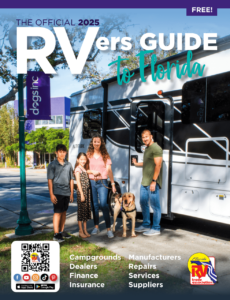Going RVing This Spring? Here Are Some Tips to Keep In Mind
Snow is melting, the sunshine is pouring out more readily, and temperatures are rising. This must mean that spring is just around the corner, and for many diehard Airstreamers, this symbolizes the start to a brand new travel season. While some fellow travelers wait until summer to take their rig out on the road, it’s more than understandable if your feet start itching and you can’t wait any longer.
That being said, there are some things to take into consideration to make your spring journey as enjoyable and safe as possible. To help your trip go smoothly, here are a few tips to keep in mind:
Prepare for Fast-Changing Weather Conditions
Spring bridges the gap between winter and summer, and sometimes it seems as though the weather can’t decide which side of the spectrum to lean toward. For example, parts of Colorado often have days in the spring that are closer to an early summer afternoon, reaching into the 70s and even 80s, but one day later, temperatures will drop into the 50s or below. It’s also not unheard of to have a streak of warm weather immediately followed by a powerful snowstorm.
The point is that spring weather can often be unpredictable, and you don’t want to run the risk of getting too hot or too cold because you are unprepared. It’s important to pack for all possibilities, and do your research ahead of time about what to reasonably expect for the particular location you’re heading to, as well as the areas you’ll be traveling through.
It’s a good idea to pack sunscreen and warm-weather clothing, but you’ll also want to bring an umbrella, heavy outerwear, warm bedding, etc.–the more diverse weather you pack for, the better you will be prepared and fully enjoy your trip.
Know Your WildLife Safety Precautions
Spring is the season where life emerges from its cold-weather slumber, and to best protect yourself and your family, it’s important to understand what precautions to take if you’re going to be adventuring in territory where bears, mountain lions, and moose are likely to be found.

Hunger and warmer temperatures drive bears out of their hibernation, and while bear attacks are quite rare, they are more likely to be aggressive when they are hungry or if they have their cubs with them. On a similar note, moose often have their calves with them in the spring, and they too can be more likely to attack if they feel that they need to protect their young. To help you stay safe, here are a few tips to keep in mind:
- Always carry a deterrent with you, such as bear spray, when you are in the bear-friendly land, and make sure it’s in an easy-to-reach area and you are familiar with how to use it.
- Sneaking up and surprising a wild animal can increase the likelihood of being attacked. If you’re going to be wandering around in the great outdoors, make consistent noise by singing a song out loud and clapping your hands loudly together to let any nearby creatures know you’re there.
- Animals are less likely to attack if they encounter a large group of people, so try to travel in groups of three or more and stick close together.
- If you do spot a wild animal, never try to approach it.
- Never attempt to feed a wild animal.
- Keep a clean campsite, as bears have an excellent sense of smell. Keep food and trash in a bear-proof container (many campgrounds offer bear canisters and lockers), and thoroughly clean up any spills, crumbs, or dirty dishes to avoid drawing a bear to your campsite. Bears have broken into vehicles, so to stay safe, keep food away from the place you’ll be sleeping.
- Bears can also be drawn to anything with a strong scent, so you’ll also want to lock up toothpaste, gum, bug spray, etc.
- If a trail says that no dogs are allowed, respect the guideline, as it’s most likely set in place to protect you and your canine friend. Dogs don’t understand wildlife safety tips and could aggravate a bear, cougar, or moose.
- If you’re not confident in your ability to handle a wild animal, there’s no shame in playing it safe and sticking close to a populated campground.
- It’s not all about big animals, either. Know what types of snakes, spiders, and insects will be around and plan safety measures accordingly.
* Please keep in mind that these are general wildlife safety tips. To best protect yourself, educate yourself on what specific types of animals live near the unique area you’ll be staying, and further research what precautions to take.
Book Your Reservations at Campgrounds Well In Advance
The RV community is nothing if not passionate and motivated about travel, so don’t for one second think that you’re the only one itching to get out on the road once the weather finally warms up. Popular destinations can fill up quickly, as some diehard RVers even book spots in winter just to secure a spot at their favorite location in the spring. If you want to park your rig at a prime park, you’ll be doing yourself a favor if you take a few minutes to call and confirm a reservation.
Protect Your Skin From the Sun
Just because the sun isn’t overbearing quite yet and the weather is not blistering hot doesn’t mean that you shouldn’t take skincare precautions. RVers love to bask in the beautiful outdoors, but many only stress the importance of sun protection when summer is in full swing.
UV rays can still cause damage when the weather is cool, and nobody wants a sunburn dampening their journey. To keep your skin healthy and comfortable, here are a few tips:
- Sunscreen with SPF 30 or higher should be part of any outdoor lover’s daily routine, so apply it often and generously.
- Creating shade with your awning allows you to bask in the open air while getting relief from the sun. The only thing is to remember to retract your awning before going to bed. As we mentioned above, spring weather can often be unpredictable, and you don’t want a sudden storm or drop in temperatures to ruin your awning.
- Try to find an RV park that is abundant in trees. This provides you with natural shade, and it can also help you naturally cool off the inside of your RV during the day if the weather heats up.
Thoroughly Evaluate Your RV’s Mechanical Wellbeing
If your rig has been set aside in storage for the entirety of the cold season, it’s important to make sure it’s in tip-top shape before taking it on a lengthy adventure. Tires can acquire flat spots, mold/mildew can begin to form, rodents can get in and chew through important electrical wires, etc.
The last thing that you want is to set your sights on an exhilarating, much-needed vacation only to get a few miles down the road before you realize something isn’t right. If you’re not mechanically inclined yourself, be sure to take your RV to a professional who can make sure your battery, water system, plumbing, breaks, and everything else are in good shape for travel. While your enthusiasm about hitting the road after a long season void of traveling is understandable, a spring check up for your RV will help ensure that you’ll have a road trip that’s just as safe as it is euphoric.
Takeaway Points
For those people out there who hold RVing near and dear to their hearts, there are few things as satisfying than embarking on the first big trip after a travel dry spell, but it’s important to find the balance of excitement and practicality. If you prepare well for various weather conditions, research the area you’ll be visiting ahead of time, and prioritize your RV’s mechanical safety, you should have no problem making your adventure into something truly life-affirming.

